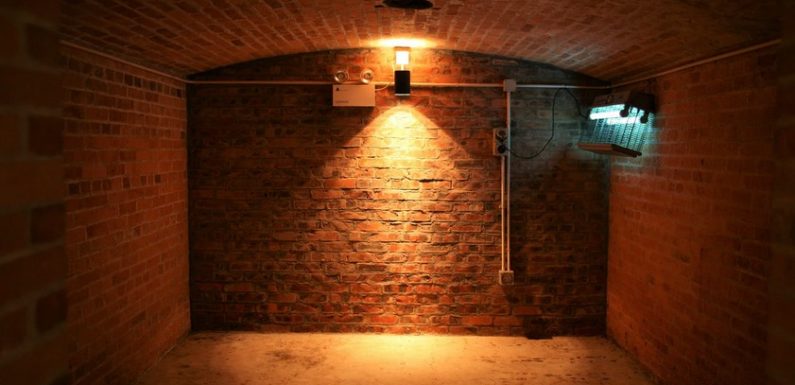
Homeowners dread water problems in the basement for good reason. Not only is removing water from basements a nuisance, but some basements’ susceptibility to water damage render them practically useless—they can’t function as living spaces or even reliable storage spaces. Basement construction is expensive on a per-square-foot basis, so the value of this compromised space is significant.
Table of Contents
Sources of Basement Leaks
Many leaks in the basement come from the inside—for instance, from a burst pipe. Usually, you’ll discover this problem pretty quickly and turn off the main water supply valve until the repair is made.
But many serious basement water problems come from outside the house, and water from the outside is not as manageable. If your foundation is old, poorly installed, or located near an underground spring, wet weather can result in a wet basement. To stop water from getting in:
- Keep the soil around your house graded away from the foundation walls.
- Keep gutters and downspouts in good working order.
- Install a perimeter drain system next to the foundation footing to carry water away from the house.
How to Install a Perimeter Drain System
Installing a perimeter drain system is an effective way to prevent basement leaks but can also be difficult, time-consuming, and expensive. It involves the following steps:
- Excavate the soil around the house to the bottom of the foundation footing, usually 8–10′ deep and about 2–3′ wide. Unfortunately, you’ll have to temporarily remove (and possibly damage) foundation plantings, including perennial bushes, flowers, and groundcovers, as well as patios, decks, and walkways.
- Pour crushed stone into the excavation along the side of the footing and place a perforated plastic drainpipe on the crushed stone. Pitch this pipe down toward one corner of the building so that it drains all the groundwater to one point.
- Pour more crushed stone on the top and sides of the pipe (about 12″ around). Cover with landscape fabric to keep soil from clogging the drain holes in the pipe.
- Clean the outside surfaces of the foundation walls with a hose or pressure washer. Once dry, coat them with an asphalt-based sealer; you may also embed roofing felt or another fabric in the surface.
- Next, excavate a ditch for the pipe that connects the drain lines to your local sewer line (be sure to get permission from your local government first) and the connection to the sewer made by the utility. In rural areas, you’d usually install this pipe so that it drains onto a lower part of the property.
- Once you’ve made all the connections, fill the excavation with the soil that you removed. Return plantings, walks, patios, etc. to their original places.
Other Ways to Avoid Basement Water Problems
If you don’t want to take on the arduous task of installing a perimeter drain system, the next best choice is to install an interior drain line. This is a plastic channel located around the inside of the basement wall that is sloped into a sump pump hole, where it empties. When the water in the sump pump’s reservoir starts to rise, the pump turns on and sends the water up onto the lawn, at least 10′ away from the house, where it’s absorbed by the soil. Although they do a good job of removing water, interior systems are not nearly as good as exterior systems—the best approach is to keep the water out in the first place.
How to Fix Minor Basement Water Problems
Minor basement water problems, such as dampness or an occasional pipe leak, require less drastic measures.
How to Clean Up Small Amounts of Basement Water
A wet/dry vacuum is your first defense against small amounts of water in the basement. A 3-horsepower unit with a 5-gallon tank can make short work of 1–2″ of standing water.
How to Fix a Musty Smell in the Basement
If your basement is dry but has a musty smell, water vapor is likely coming through the walls and/or floor. You can seal these surfaces by brushing on waterproof coatings sold at home improvement stores.
How to Fix Basement Window Water Leaks
Basement windows can be the source of water leaks, especially windows located inside window wells that don’t drain properly. A good solution is to replace the old wells with enclosures that have clear plastic tops.
How to Keep Basement Carpeting Dry
Don’t install carpeting on basement floors without a vapor barrier underneath. By installing a vapor-proof subfloor, such as the interlocking tiles shown here, moisture can’t reach the carpet and cause mold to form.
How to Keep Basement Wood Flooring Dry
Basement wood flooring will also rot without a good vapor barrier underneath. Many laminate flooring products are designed to float over a resilient plastic pad that keeps moisture from reaching the wood.
How to Keep Basement Drywall Dry
Many building codes require a vapor barrier and insulation when you’re finishing your basement walls with drywall. The best insulation to use is moisture-proof polystyrene panels, shown here.
HH55MqjEtug


